2.02.2021
STARSHIP SN9 HIGH-ALTITUDE FLIGHT TEST
SpaceX is set to launch the Starship SN9 prototype to an altitude of approximately 10 kilometers. A launch attempt is possible between 9 am and 6 pm Central time on Tuesday. However, as with testing, there is always a chance that teams could decide to stand down and try again on a different day.







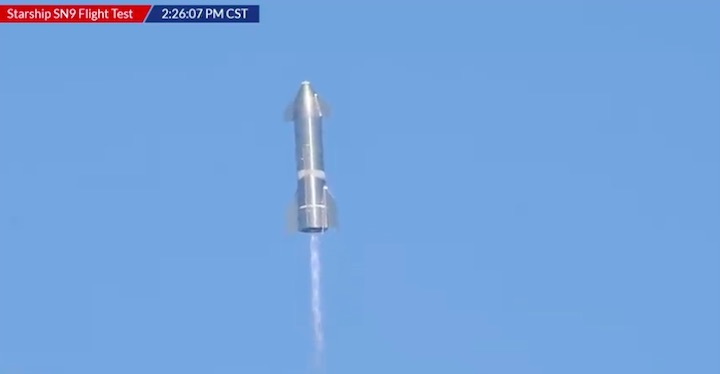







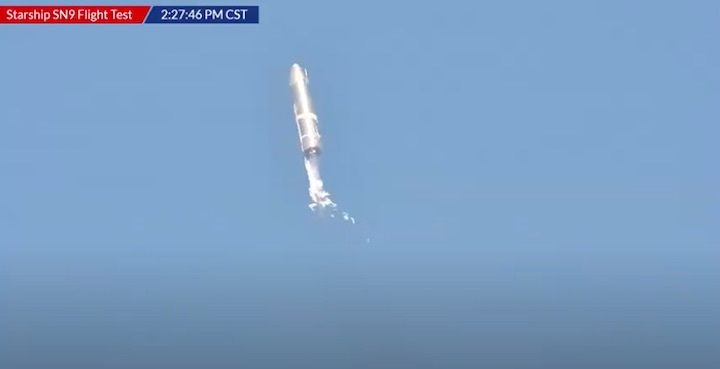
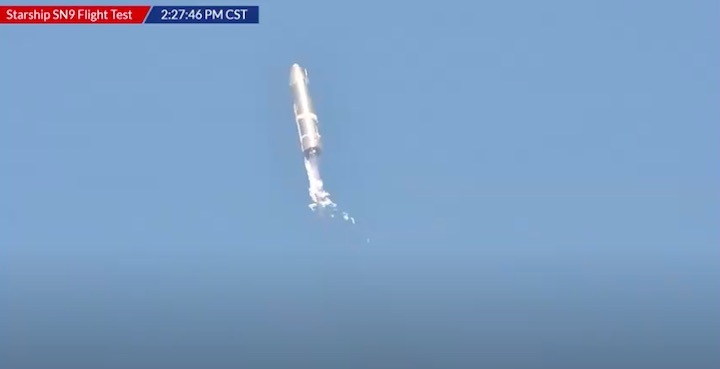







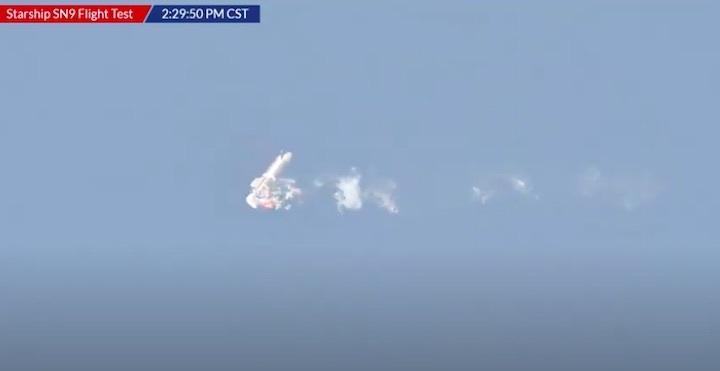


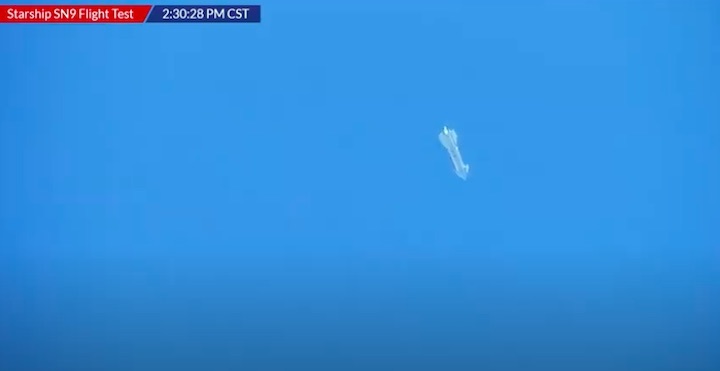




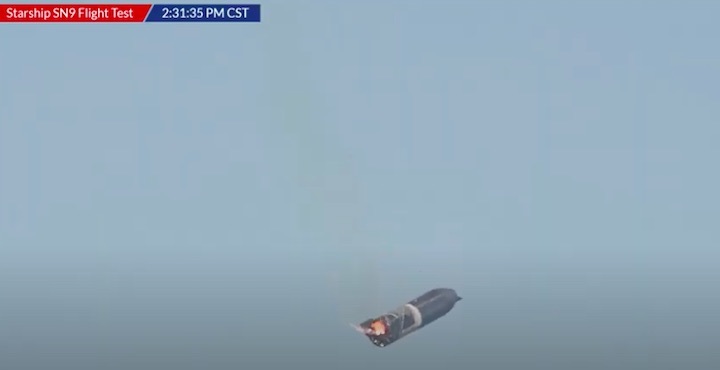
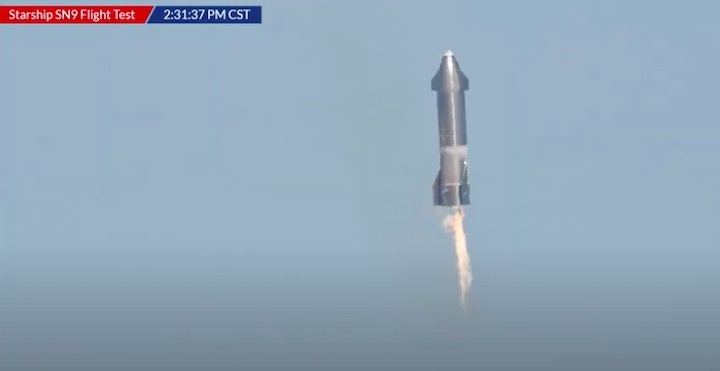

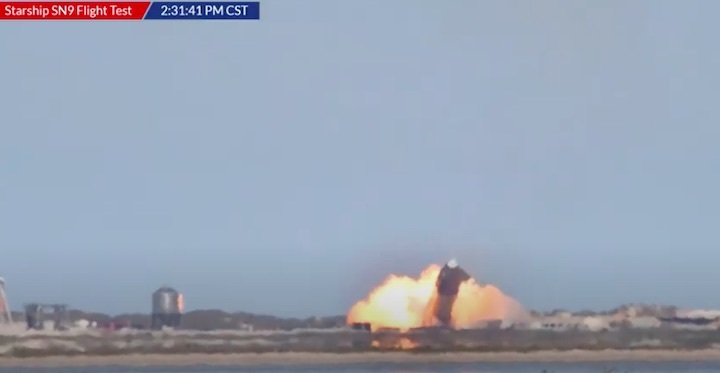







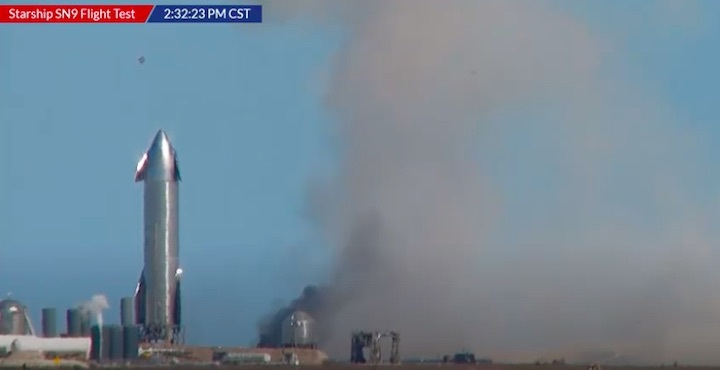
Quelle: SpaceX
----
Update: 3.02.2021
-
SpaceX launches Starship on second test flight, but SN9 explodes on impact

A futuristic SpaceX Starship prototype launched from Texas on Tuesday, successfully reaching its target altitude and performing a unique braking maneuver before an explosion consumed the vehicle during the landing phase.
At 2:25 p.m. Central time, the 165-foot Starship known as Serial Number 9, or SN9, blasted off from Boca Chica – located near the Texas–Mexico border – on a brief test flight. It automatically throttled down its Raptor engines at about 33,000 feet, then performed a "belly flop" maneuver using adjustable fins to establish a trajectory back toward the launch site.
Though the test achieved SpaceX's primary objective, SN9 failed to fully flip from "belly-down" to an upright position, causing it to explode on impact.
"We had again another great flight up to a 10-kilometer apogee, demonstrated the ability to transition engines to the landing propellant tanks, and the subsonic entry looked very good and stable," John Insprucker, an engineer at SpaceX, said during the company's webcast. "We've just gotta work on that landing a little bit."
SN9 exploded near SN10, another Starship prototype slated for liftoff sometime soon. Tuesday's flight followed SN8's launch in December, which saw a similar trajectory and outcome: the vehicle was lost, but it showed SpaceX is on the right path when it comes to making the next-generation vehicle work.
"We got a lot of good data," Insprucker said after the test. "The primary objective, to demonstrate control of the vehicle during subsonic re-entry, looked to be very good."
Starship is just half of the company's next-generation system: it will fly atop Super Heavy, a massive booster that will take it to orbit with cargo and, someday, dozens of human passengers. SpaceX founder Elon Musk views Starship as the vehicle that will bring to life his vision of settlements on the moon and Mars.
Eventually, Musk wants to see Starships launch from Texas, Kennedy Space Center in Florida, and even two former oil rigs already purchased by SpaceX: Phobos and Deimos, named after two moons of Mars. Ocean-based launches would give teams more flexibility on timing, trajectories, and regulations.
But Tuesday's flight wasn't without drama. Musk and the Federal Aviation Administration, which ultimately gives the green light for launch providers, had a public falling out last week when SN9 was first scheduled.
The FAA refused to grant flight permissions, noting that SpaceX had failed to meet public safety requirements in December.
"Prior to the Starship SN8 test launch in December 2020, SpaceX sought a waiver to exceed the maximum public risk allowed by federal safety regulations," an FAA spokesperson told FLORIDA TODAY. "After the FAA denied the request, SpaceX proceeded with the flight."
As a result, the FAA said, SpaceX was required to conduct an investigation into the incident. An updated launch license was granted late Monday.
Musk last week took his grievances to Twitter, which was teeming with speculation on when the prototype might finally fly.
"Unlike its aircraft division, which is fine, the FAA space division has a fundamentally broken regulatory structure," Musk said. "Their rules are meant for a handful of expendable launches per year from a few government facilities. Under those rules, humanity will never get to Mars."
Quelle: Florida Today
----
Update: 16.02.2021
.
SpaceX Starship to test landing upgrades after two explosions

After two Starship prototypes aced their high-altitude launch debuts only to suffer last-second landing failures for unique reasons, SpaceX is gearing up for a third launch as early as this week.
Crucially, though Elon Musk’s levelheaded realism (or pessimism) has often seemed to underestimate the actual odds of success, the SpaceX CEO is substantially more confident on Starship’s third launch attempt than he was on the first flight two months ago. Back when Starship serial number 8 (SN8) was preparing to attempt the program’s first high-altitude launch, Musk pegged the probability of a successful launch, freefall, and landing at ~33%.
As it turned out, he wasn’t wrong, but Starship SN8 ultimately made far closer to a total success than almost anyone – inside SpaceX or not – expected it to get on the first try. Less than two months later, Starship SN9 suffered a similar last-second landing failure more than six minutes into the flight, though the root causes of both failures were unique.
After two Starship prototypes aced their high-altitude launch debuts only to suffer last-second landing failures for unique reasons, SpaceX is gearing up for a third launch as early as this week.
Crucially, though Elon Musk’s levelheaded realism (or pessimism) has often seemed to underestimate the actual odds of success, the SpaceX CEO is substantially more confident on Starship’s third launch attempt than he was on the first flight two months ago. Back when Starship serial number 8 (SN8) was preparing to attempt the program’s first high-altitude launch, Musk pegged the probability of a successful launch, freefall, and landing at ~33%.
As it turned out, he wasn’t wrong, but Starship SN8 ultimately made far closer to a total success than almost anyone – inside SpaceX or not – expected it to get on the first try. Less than two months later, Starship SN9 suffered a similar last-second landing failure more than six minutes into the flight, though the root causes of both failures were unique.
In other words, both flight tests served their nominal purpose, uncovering two failure modes that would have eventually reared their heads one way or another. With SN8, Starship was unable to maintain enough pressure in its secondary landing fuel tank to supply two Raptor engines with enough fuel for a landing burn. Starship SN9 failed a few seconds before SN8 when one of the two Raptor engines needed for a flip and landing burn never ignited, causing the rocket to smash into the ground at an angle relative to SN8’s tail-down impact.
As previously discussed on Teslarati, Elon Musk eventually revealed his opinion that SN9’s engine-out failure was potentially avoidable and that SpaceX would change the way future Starships attempt to land in a bid to add more redundancy.
“While SpaceX obviously hasn’t spun around and fixed a complex Starship propulsion issue in a matter of days, Musk eventually revealed his opinion that he, his engineers, or some combination of both “were too dumb” to exploit one obvious way to mitigate the risk of engine failure during [Starship SN9’s] flip and landing. That ‘obvious’ tweak: reignite all three of Starship’s available landing engines, not just two.”
By igniting not just two – but all three – Raptor engines during Starship’s flip burn, SpaceX could essentially perform a midair static fire, giving the rocket’s flight computer a few seconds to analyze performance and downselect to the two healthiest engines for the final landing burn. With that change implemented, Starship would theoretically have enough redundancy to land if only two of its three sea-level Raptors performed nominally.
Currently installed on one of two ‘suborbital stands’ at SpaceX’s South Texas launch pad, Starship SN10 will be the first high-altitude prototype to attempt that three-engine flip burn and on-the-fly downselect. Musk says his confidence that SN10 will successfully land is now 60%, an almost twofold improvement over SN8. Starship SN10 could potentially fly as early as this week, though the prototype still needs to complete a nominal three-engine static fire test and the launch has yet to receive FAA approval.
Further down the road, Musk says that SpaceX is working hard to improve Raptor’s deep throttle performance, potentially allowing future Starships to burn two – or even three – engines all the way to touchdown for even more redundancy. Deep-throttling large, complex rocket engines is extraordinarily difficult, though, so that upgrade is likely no less than several months away. In the meantime, Starship SN11 is effectively complete and Starships SN15 through SN18 are being assembled to support a relentless flight test campaign as SpaceX works towards orbital flights.
Quelle: TESLARATI
